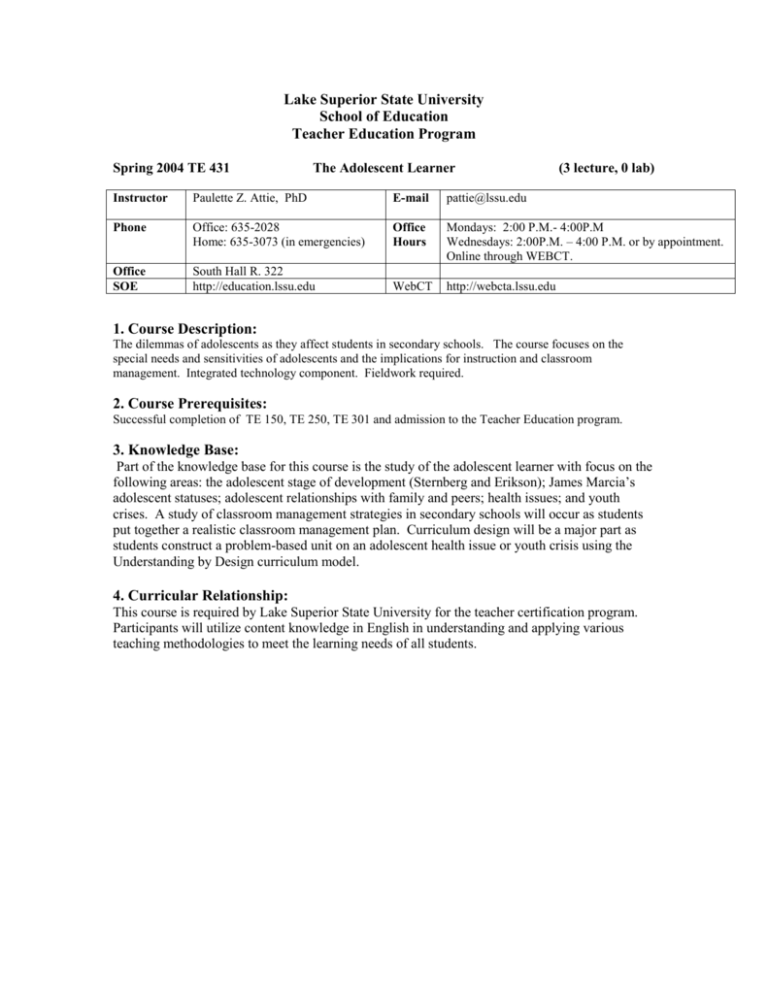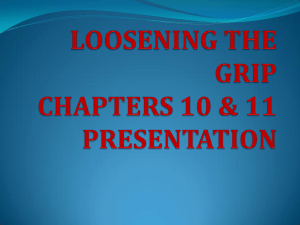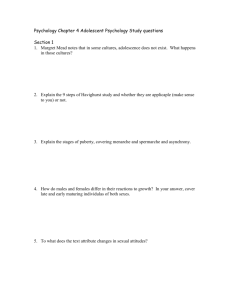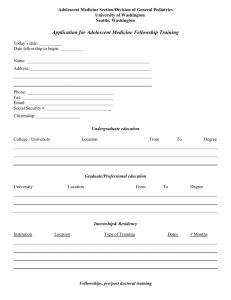431 The Secondary Learner - Lake Superior State University
advertisement

Lake Superior State University School of Education Teacher Education Program Spring 2004 TE 431 The Adolescent Learner (3 lecture, 0 lab) Instructor Paulette Z. Attie, PhD E-mail pattie@lssu.edu Phone Office: 635-2028 Home: 635-3073 (in emergencies) Office Hours Mondays: 2:00 P.M.- 4:00P.M Wednesdays: 2:00P.M. – 4:00 P.M. or by appointment. Online through WEBCT. Office SOE South Hall R. 322 http://education.lssu.edu WebCT http://webcta.lssu.edu 1. Course Description: The dilemmas of adolescents as they affect students in secondary schools. The course focuses on the special needs and sensitivities of adolescents and the implications for instruction and classroom management. Integrated technology component. Fieldwork required. 2. Course Prerequisites: Successful completion of TE 150, TE 250, TE 301 and admission to the Teacher Education program. 3. Knowledge Base: Part of the knowledge base for this course is the study of the adolescent learner with focus on the following areas: the adolescent stage of development (Sternberg and Erikson); James Marcia’s adolescent statuses; adolescent relationships with family and peers; health issues; and youth crises. A study of classroom management strategies in secondary schools will occur as students put together a realistic classroom management plan. Curriculum design will be a major part as students construct a problem-based unit on an adolescent health issue or youth crisis using the Understanding by Design curriculum model. 4. Curricular Relationship: This course is required by Lake Superior State University for the teacher certification program. Participants will utilize content knowledge in English in understanding and applying various teaching methodologies to meet the learning needs of all students. STAGE I of Curriculum Design: Desired Results 5. Course objectives aligned with MELS (Michigan Entry Level Standards): At the end of this course, pre-service teachers will be able to: Course Objectives: a. understand the dilemmas of adolescence and implications for teachers of adolescents; b. understand the diversity that characterizes the secondary student population vis-à-vis gender, culture, socioeconomic status, special needs, “at-risk” etc.; c. understand the importance of communication to work effectively with students, parents, administrators, and faculty; d. understand some of the legal issues in teaching especially as they relate to classroom management; e. develop a classroom management plan to meet secondary students’ behavioral and learning needs; f. identify and understand identity development, peer and family relationships, and unique challenges that affect the secondary student; g. identify and understand major health issues that affect the adolescent population; h. develop a technology -enhanced unit plan of study that addresses a major adolescent health issue or crisis; i. understand the concept of preventive classroom management in assuring an environment that promotes learning; j. understand that instruction and classroom management tie together; i.e., that management strategies enhance instruction and that hands-on, active learning eliminates management crises. k. develop an appreciation for the need to be life-long learners as a function of changing opportunities and demands in the workplace; l. exercise skills in reading, writing, speaking, and listening effectively; m. interrelate, analyze, and synthesize major theoretical constructs in adolescent psychology; n. develop an understanding of the tension between theory and practice in the field experience setting Michigan Entry Level Standards: Standard 2: a Standard 1 : f, g Standard 2: g, h Standard 5: a Standard 4: c, d, Standard 5: f Standard 6: e Standard 4: f Standard 2: b, d, e, f, h Standard 3: a, d Standard 2: a Standard 5: a Standard 2: a Standard 1: h Standard 3: b, d Standard 5: a Standard 6: a, b Standard 7: a Standard 2: d, h Standard 3: d Standard 4: a Standard 1: g, k Standard 2: a, b, d, e, f, g, h Standard 3: a, d, f Standard 4: a, b Standard 5: b, c, h Standard 6: e Standard 7: d Standard 3: g Standard 5: e Standard 7: b Standard 1: a Standard 2: a, b Standard 5: f, h 6. GUIDING STANDARDS The following standards will guide the content and the instructional strategies throughout the course: Michigan Entry Level Standards for Teachers – posted on WEBCT Educational Technology Standards (NETS) STAGE 2 of Curriculum Design: Acceptable Evidence of having achieved the Desired Results: 7. Course requirements and assessments: What evidence do you need to present to demonstrate your mastery of the course objectives? A. Field experience requirements – 12-15 hours in a secondary language arts classroom Field experience log Professional dispositions evaluation Field experience questions Option: Transitions Conference at LSSU for additional hours toward field experience A. Weekly reading and written assignments- texts, periodicals, and handouts – see outline of assignments B. A total of four, 4-page (double spaced, 12 font) papers that demonstrate your understanding of such major adolescent issues as identity status, relationships, and challenges in select case studies in Adolescent Portraits. C. 1 Unit Plan Using the Understanding by Design Unit Plan Template (available on School of Education website: (http://education.lssu.edu), plan and develop a technology-enhanced unit plan that addresses a major health issue or youth crisis of adolescents. Use resource websites like ADOL and site them in the Unit Plan. E. Classroom management philosophy and plan outline– 5-pages10-minute presentation F. Oral Presentation of Unit Plan on major adolescent health issue or crisis. - 25 minutes G. School of Education Content Modules in Technology: (http://ptft.merit.edu) 1. Using KidPix, create 5 paint slides to tell or “paint” a story, or create a story “flip book” with KidPix. (Module 8) 2. Create a HyperStudio stack using the HyperStudio template (Module 8) 3. Create a student storyboard for planning a KidPix or HyperStudio presentation. (Module 8)* 4. Create a rubric for a project-based learning activity using RUBISTAR (http://rubistar.4teachers.org/index.php) and/or PBL checklists. (Module 4) 5. Create a student-authored webpage for a single computer in the classroom. (Module 7) 6. Create a webpage evaluation rubric for a primary or intermediate class. Use Loogootree Elementary West’s site for ideas. (Module 7) 7. Integrate technology in the creation of 2 forms of assessment for a K-12 unit. (Module 5) 8. Create a WebQuest (Module 3) H. Weekly attendance and participation/ late work You are expected to be on time and present in class. Patterns of absenteeism and tardiness detract from your professional dispositions as a pre-service teacher candidate and your overall progress in this class. We meet so infrequently that I really do expect you to be at each class session. Your grade will be lowered if you are excessively absent primarily because if you are not in class, you cannot participate effectively in the learning community. Active participation includes completing assigned readings, unit plan, presentations, and actively discussing scheduled issues and topics. Your field experience work is the ultimate means of participation; it is your opportunity to observe and practice some of the theory and ideas presented and discussed in class. Late work will only be accepted with serious documentation for absences. Please see or contact me before the due date of any assignment if a grave situation will cause you to know in advance that your work will be late. 8. Assessment: Attendance/Participation/Professional Dispositions……..15% Field Work …………………………………….. 10% Written Work……………………………………40% Unit Plan Classroom Management Plan 4 Case Study Analyses Oral Presentations………………………………20% School of Education Technology Assessments….15% Grading: 98 – 100 A+ 94 – 97 A 90 – 93 A - 88 – 89 B+ 84 – 87 B 80 – 83 B- 78 – 79 C+ 74 – 77 C 70 – 73 C- Please Note Check WebCT often. All course work must be either word processed or typed (except for response journals). Written work should follow APA Publication Manual Guidelines. Changes may be made to this syllabus at the discretion of the instructor. STAGE 3 of Curriculum Design: Planning Learning Experiences and Instruction 9. Required Texts: Adolescent Portraits: Identity, Relationships, and Challenges. Andrew Garrod, [et. al.], Boston, MA. Allyn and Bacon, 2002. Managing Secondary Classrooms: Principles and Strategies for Effective Management and Instruction. Patricia Williams, [et.al.], Needham Heights, MA, Allyn and Bacon, 1999. 10. Resource Websites LSSU School of Education http://education.lssu.edu School of Education Required technology assessments Classroom Management: 1. Education World a. Teacher resources in classroom management b. The Classroom Problem Solver c. Classroom Management d. Motivation -“QUIA”– Free online design of games and puzzles using your own content. http://ptft.merit.edu 2. The Educator’s Reference Desk a. Classroom management b. Templates for Teachers c. Classroom Management Profile 3. Required* technology modules for TE Methods classes *School of Education Requirement to meet Technology Standard 7 of the MELS. 4. Adolescent Issues a. Adolescent Directory On Line (ADOL) b. Adolescent mental health issues c. Adolescent health risks d. Adolescents with disabilities 5. Adolescent Identity and Psychosocial Development a. Erik Erikson Stages of Adolescent Development b. Summary Chart: Erikson c. James Marcia’s Identity a. http://www.educationworld.com/a_curr/archives/ b. http://www.educationworld.com/a_curr/archives/shore.shtml c. http://www.educationworld.com/a_curr/curr154.shtml c. http://ss.uno.edu/ss/homepages/cmanage.html d. http://www.quia.com/findout.html a. http://eduref.org/cgibin/print.cgi/Resources/Teaching/Classroom_Management.html b. http://www.educationworld.com/a_tech/tech101.shtml c. http://education.indiana.edu/cas/tt/v1i2/what.html Preparing Teachers for Tomorrow a. http://ptft.merit.edu Modules 3, 4, 5, 7, 8 a. http://education.indiana.edu/cas/adol/adol.html b. http://education.indiana.edu/cas/adol/mental.html c. http://education.indiana.edu/cas/adol/risk.html d. http://inside.bard.edu/academic/specialproj/darling/adolesce.htm a. http://psychology.about.com/library/weekly/aa091500b.htm b. http://web.cortland.edu/andersmd/ERIK/sum.HTML c. http://www.unm.edu/~jka/courses/archive/ident.html Status d. Adolescent development notes e. Early and Middle Adolescent development Table 6. Relationships a. Teen and family issues b. Changes in family relationships c. Peer groups, cliques, crowds d. Center for Adolescent and family studies d. http://www.unm.edu/~jka/courses/archive/adoles.html e.http://eesc.orst.edu/agcomwebfile/edmat/html/ec/ec1527/ec1527.html a. http://www.focusas.com/Resources.html#Adolescence b. http://inside.bard.edu/academic/specialproj/darling/adolesce.htm c. http://inside.bard.edu/academic/specialproj/darling/adolesce.htm d. http://www.iub.edu/%7Ecafs/resource.html 10. Course Outline and Assignments This outline of assignments may change at the discretion of the instructor. Class Agenda/Topics Week 1: January 14 Introduction Syllabus Field Experience Requirements Adolescent development theory/Erikson Adolescent Identity Issues/ Marcia Unit Plan Template Assignment for the following week 1.Handout 431-a Middle Childhood and Adolescent Dev. 2.Handout 431-b Erikson’s psychosocial view of development 3.Handout 431-c James Marcia’s Theory of Identity Formation 4.Handout 431-d Questions Part I in Adolescent Portraits 5. In Adolescent Portraits, Case Study 3 “The Chances…” 6. Prepare written notes on questions in AP reading – Handout 431-d on Case Study 3. 7. In Managing Secondary Classrooms, Chapters 1 and 13 8. p. 232 Activity 13.2 Philosophy of Classroom Management Brief , 2-page outline of Activity 13.3 Philosophy of Classroom Management Week 2: January 21 Designing a classroom management plan: p.235 Developing a learning community Classroom rules Sample classroom management plan Adolescent development Identity Statuses Case Study 3 small group discussion on 431-d questions Unit Plan Template-Backward Design Stages I, II, III Enduring Understandings Essential Questions 1. In Managing Secondary Classrooms, Chapters 2, 8 Week 3: January 28 No formal class. See Assignments from January 21. Due: February 4 2. Written Assignment: Activity 2.2 Research one of the Supreme Court cases on the internet. Write a 1-2 page description of case and how it affects you in the classroom. 3. In Adolescent Portraits, read 2 Case Studies from PART I and follow instructions on Handout 431-d for two papers. Due February 4. (Do not choose Case Studies 3 or 7.) 4. Understanding by Design Handouts 5. Enduring Understandings Worksheet 6. Essential Questions Worksheet and InTel CD index 1. Case law research paper- 1 CASE 2. Papers on two case studies in Adolescent Portraits- Use form 431-d for questions. Week 4: February 4 Supreme Court Case Law Family Rights and Privacy Act 1972 Corporal punishment Codes of Conduct Suspension and expulsion Special Education students Sexual Harassment Search and Seizure Censorship Judicious Discipline Identity Statuses in Case Studies that you wrote about. 1. Adolescent Portraits, Case Study 7, Reflections, and Follow –Up, pp. 86-115. 2. Prepare written notes on questions TE 431-d for Case 7. 3. Managing Secondary Classrooms, Chapters 3, 5 Preventive Management 4. Select three possible topics on adolescent health issues or crisis for unit plan. Week 5: February 11 Case Study 7 discussion Preventive Management: First Days Guest Speaker? Unit plan topics decided 1. DUE: February 25 Unit Plan on adolescent health issue or crisis. Use Unit Plan Template on School of Education website Use Resource websites to get started. Remember to use technology Student-centered approach Project-based Intel CD as resource (http://ptft.merit.edu) as resource all sections of template completed 2. In Managing Secondary Classrooms,, Chapter 6, Managing Instruction 3. Written assignment: 1-2 pages. Define such terms as Premack principle, shaping, and fading and explain how these help or hinder learning. Week 6: February 18 – No formal class: Conference Week 7: February 25 Guest Speaker: Classroom management 2 unit plan presentations DUE MARCH 10: 1. Adolescent Portraits, Part II, Relationships pp.129-134 2. Choose one of the following case studies: 10, 11, 13, 14 3. In a 4-page (minimum) paper address the questions on Handout 431-e. for one of the case studies (10, 11, 13, 14) 4. Adolescent Portraits, Read CASE STUDY 9 for class discussion March 3: SPRING BREAK Week 8: March 10 2 unit plan presentations Discussion Case Study 9 Adolescent family relationships Peer Relationships Cliques, Crowds, Peers ☺☺☺☺☺☺☺☺☺☺☺☺☺☺☺☺☺☺☺ 1. Adolescent Portraits, Part III. Challenges pp.249-25 2. Choose one of the following case studies: 15,17, 18 3. In a 4-page (minimum) paper, address the discuss the particular challenges that confront the adolescents in one of the case studies (15, 17, *18) 4. *Read Case Study 18 for class discussion. Week 9: March 17 4 unit plan presentations Discussion Case Study 18 Youths in Crises (Social Problems) Week 10: March 24 4 unit plan presentations Communication Strategies- Students, parents, administrators, your peers 5. Managing Secondary Classrooms, Chapter 10 1. Managing Secondary Classrooms, Chapter 4 2. Work on Classroom Management Plan 3. Work on incorporating School of Education technology assessments in unit plan. 1.Managing Secondary Classrooms, Chapters 11, 12 2. Work on Classroom Management Plan 3. Work on incorporating School of Education technology assessments in revised unit plan. Week 11: March 31 4 unit plan presentations Students with Special needs Cultural Differences 1. Work on Classroom Management Plan 2. Work on incorporating School of Education technology assessments in revised unit plan. Week 12: April 7 Submit Classroom management plan electronically to WEBCT. 4 unit plan presentations Week 13: April 14 4 unit plan presentations Week 14: April 21 4 unit plan presentations Collect Field Experience log, reflection, evaluation 1. Field experience papers due April 21 or April 28. 2. Work on incorporating School of Education technology assessments in revised unit plan. 1. Hardcopy of Revised Unit Plan due on 4/28 that incorporates the School of Education Technology Assessments for this course. 2. Submit revised Unit Plan template electronically. 2. Hardcopy of classroom management plan due 4/28. 3. E-pad due with School of Education technology requirements on 4/28 Week 15: April 28 6 unit plan presentations Wrap up 11. In compliance with Lake Superior State University policy and equal access laws, disability-related accommodations or services are available. Students who desire such services are to meet with the professor in a timely manner, preferably the first week of class, to discuss their disability-related needs. Students will not receive services until they register with the Resource Center for Students with Disabilities (RCSD). Proper registration will enable the RCSD to verify the disability and determine reasonable academic accommodations. RCSD is located in South Hall office 206. The telephone number is (906) 535-2454.





